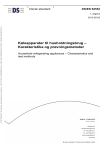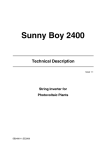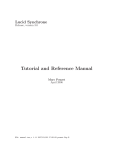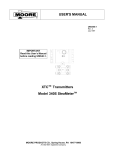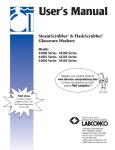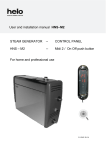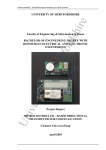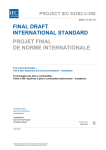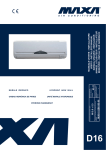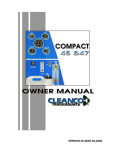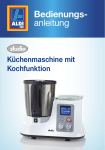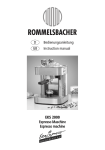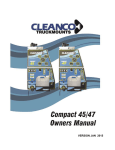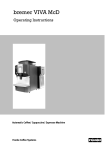Download Metoder til måling af ydeevne for elektriske kaffemaskiner til
Transcript
Dansk standard DS/EN 60661 2. udgave 2014-05-08 Metoder til måling af ydeevne for elektriske kaffemaskiner til husholdningsbrug Methods for measuring the performance of electric household coffee makers DS/EN 60661 København DS projekt: M278016 ICS: 97.040.50 Første del af denne publikations betegnelse er: DS/EN, hvilket betyder, at det er en europæisk standard, der har status som dansk standard. Denne publikations overensstemmelse er: IDT med: IEC 60661 ED 2.2:2004. IDT med: EN 60661:2014. DS-publikationen er på engelsk og fransk. Denne publikation erstatter: DS/EN 60661:2001, DS/EN 60661/A2:2006 og DS/EN 60661/A1:2003. DS-publikationstyper Dansk Standard udgiver forskellige publikationstyper. Typen på denne publikation fremgår af forsiden. Der kan være tale om: Dansk standard • standard, der er udarbejdet på nationalt niveau, eller som er baseret på et andet lands nationale standard, eller • standard, der er udarbejdet på internationalt og/eller europæisk niveau, og som har fået status som dansk standard DS-information • publikation, der er udarbejdet på nationalt niveau, og som ikke har opnået status som standard, eller • publikation, der er udarbejdet på internationalt og/eller europæisk niveau, og som ikke har fået status som standard, fx en teknisk rapport, eller • europæisk præstandard DS-håndbog • samling af standarder, eventuelt suppleret med informativt materiale DS-hæfte • publikation med informativt materiale Til disse publikationstyper kan endvidere udgives • tillæg og rettelsesblade DS-publikationsform Publikationstyperne udgives i forskellig form som henholdsvis • fuldtekstpublikation (publikationen er trykt i sin helhed) • godkendelsesblad (publikationen leveres i kopi med et trykt DS-omslag) • elektronisk (publikationen leveres på et elektronisk medie) DS-betegnelse Alle DS-publikationers betegnelse begynder med DS efterfulgt af et eller flere præfikser og et nr., fx DS 383, DS/EN 5414 osv. Hvis der efter nr. er angivet et A eller Cor, betyder det, enten at det er et tillæg eller et rettelsesblad til hovedstandarden, eller at det er indført i hovedstandarden. DS-betegnelse angives på forsiden. Overensstemmelse med anden publikation: Overensstemmelse kan enten være IDT, EQV, NEQ eller MOD • IDT: Når publikationen er identisk med en given publikation. • EQV: Når publikationen teknisk er i overensstemmelse med en given publikation, men præsentationen er ændret. • NEQ: Når publikationen teknisk eller præsentationsmæssigt ikke er i overensstemmelse med en given standard, men udarbejdet på baggrund af denne. • MOD: Når publikationen er modificeret i forhold til en given publikation. EUROPEAN STANDARD EN 60661 NORME EUROPÉENNE EUROPÄISCHE NORM May 2014 ICS 97.040.50 Supersedes EN 60661:2001 English Version Methods for measuring the performance of electric household coffee makers (IEC 60661:1999 , modified + A1:2003 , modified + A2:2005 , modified) Méthodes de mesure de l'aptitude à la fonction des cafetières électriques à usage domestique (CEI 60661:1999 , modifiée + A1:2003 , modifiée + A2:2005 , modifi) Verfahren zur Messung der Gebrauchseigenschaften elektrischer Haushalt-Kaffeebereiter (IEC 60661:1999 , modifiziert + A1:2003 , modifiziert + A2:2005 , modifiziert) This European Standard was approved by CENELEC on 2013-11-25. CENELEC members are bound to comply with the CEN/CENELEC Internal Regulations which stipulate the conditions for giving this European Standard the status of a national standard without any alteration. Up-to-date lists and bibliographical references concerning such national standards may be obtained on application to the CEN-CENELEC Management Centre or to any CENELEC member. This European Standard exists in three official versions (English, French, German). A version in any other language made by translation under the responsibility of a CENELEC member into its own language and notified to the CEN-CENELEC Management Centre has the same status as the official versions. CENELEC members are the national electrotechnical committees of Austria, Belgium, Bulgaria, Croatia, Cyprus, the Czech Republic, Denmark, Estonia, Finland, Former Yugoslav Republic of Macedonia, France, Germany, Greece, Hungary, Iceland, Ireland, Italy, Latvia, Lithuania, Luxembourg, Malta, the Netherlands, Norway, Poland, Portugal, Romania, Slovakia, Slovenia, Spain, Sweden, Switzerland, Turkey and the United Kingdom. European Committee for Electrotechnical Standardization Comité Européen de Normalisation Electrotechnique Europäisches Komitee für Elektrotechnische Normung CEN-CENELEC Management Centre: Avenue Marnix 17, B-1000 Brussels © 2014 CENELEC All rights of exploitation in any form and by any means reserved worldwide for CENELEC Members. Ref. No. EN 60661:2014 E EN 60661:2014 Contents -2- Page Foreword ............................................................................................................................................................. 3 1 Addition of an Introduction .................................................................................................................. 4 2 Modification to Clause 1 "Scope and object" ..................................................................................... 4 3 Modification to Clause 2 "Normative references" .............................................................................. 4 4 Modifications to Clause 3 "Definitions" .............................................................................................. 4 5 Modification to 23.2 "Taste of the coffee"........................................................................................... 5 6 Modification to Clause 25 "Descaling test" ........................................................................................ 5 7 Modification to Clause 26 "Energy consumption" ............................................................................. 5 8 Modification to 27.1 "Steam function to froth-up milk" ................................................................... 14 9 Modification to 27.2 "Steam function to heat-up water" ................................................................. 14 10 Addition of "Annex ZA (normative) Specification of cups" ............................................................. 15 11 Addition of Bibliography ..................................................................................................................... 17 -3- EN 60661:2014 Foreword This document (EN 60661:2014) consists of the text of IEC 60661:1999 + A1:2003 + A2:2005 prepared by IEC/SC 59G "Small kitchen appliances" (merged in IEC/SC 59L) and IEC/SC 59L "Small household appliances" of IEC TC 59 "Performance of household and similar electrical appliances", together with the common modifications prepared by working group CLC/TC 59X/WG 15 "Coffee makers" of CLC/TC 59X "Performance of household and similar electrical appliances". The following dates are fixed: • latest date by which this document has to be implemented at national level by publication of an identical national standard or by endorsement (dop) 2015-05-02 • latest date by which the national standards conflicting with this document have to be withdrawn (dow) 2016-11-25 Clauses, subclauses, notes, tables, figures and annexes which are additional to those in IEC 60661:1999 + A1:2003 + A2:2005 are prefixed “Z”. This document supersedes EN 60661:2001 + A1:2003 + A2:2005. EN 60661:2014 includes the following significant technical changes with respect to EN 60661:2001 and its amendments: EN 60661:2014 now takes into account Mandate M/495 "Standardisation mandate to CEN, CENELEC and ETSI under Directive 2009/125/EC relating to harmonised standards in the field of Ecodesign" and its Annex A. Attention is drawn to the possibility that some of the elements of this document may be the subject of patent rights. CENELEC [and/or CEN] shall not be held responsible for identifying any or all such patent rights. This document has been prepared under a mandate given to CENELEC by the European Commission and the European Free Trade Association, and supports essential requirements of EU Directive(s). Endorsement notice The text of the International Standard IEC 60661:1999 + A1:2003 + A2:2005 was approved by CENELEC as a European Standard with agreed common modifications. EN 60661:2014 1 -4- Addition of an Introduction Add the following between the foreword and Clause 1: Introduction IEC 60661:2006-02 (consolidated edition of IEC 60661:1999 + A1:2003 + A2:2005) focuses mainly on filter coffee makers; capsule & pad makers are completely missing, and many clauses cannot be applied to them. Therefore, a complete reworking of the standard could solve that inadequate status; this will be done later. 2 Modification to Clause 1 "Scope and object" In NOTE 2, add "and capsule and pod/pad makers" after "espresso coffee makers". 3 Modification to Clause 2 "Normative references" Replace the text by the following: The following documents, in whole or in part, are normatively referenced in this document and are indispensable for its application. For dated references, only the edition cited applies. For undated references, the latest edition of the referenced document (including any amendments) applies. EN 50564:2011, Electrical and electronic household and office equipment – Measurement of low power consumption (IEC 62301:2011, mod.) EN 60584-2, Thermocouples – Part 2: Tolerances (IEC 60584-2) EN ISO 3696:1995, Water for analytical laboratory use – Specification and test methods (ISO 3696:1987) ISO 3972:1991, Sensory analysis – Methodology – Methods of investigating sensitivity of taste ISO 4121:1987, Sensory analysis – Methodology – Evaluation of food products by methods using scales 4 Modifications to Clause 3 "Definitions" Replace definition 3.4 by the following: 3.Z1 pressure coffee maker coffee maker with water heated and forced through ground coffee and filter by steam pressure or mechanical pump 3.Z1.1 espresso coffee maker coffee maker with heated water that is forced through ground coffee and filter by steam pressure, manual piston drive or mechanical pump, with a mechanical pump pressure equal to or higher than 10 bar -5- EN 60661:2014 3.Z1.2 low pressure coffee maker coffee maker with heated water that is forced through ground coffee and filter by steam pressure, manual piston drive or mechanical pump, with mechanical pump pressure lower than 10 bar Note 1 to entry: Electrical "moka pot" coffee maker with water heated and forced through ground coffee and filter by steam pressure is a low pressure coffee maker. 5 Modification to 23.2 "Taste of the coffee" In the second paragraph, replace "ISO 3696" by "EN ISO 3696". 6 Modification to Clause 25 "Descaling test" Delete the second paragraph. 7 Modification to Clause 26 "Energy consumption" Replace the text of Clause 26 by the following: 26.Z1 Special conditions and measurement accuracy 26.Z1.1 Ambient temperature Ambient temperature condition for energy consumption measurements shall be 23 °C ± 2 °C. 26.Z1.2 Storage of appliances Appliances are stored at ambient temperature for at least 6 h before measurements. 26.Z1.3 Energy measurement accuracy a) The energy measurements shall be accurate to ± 1,5 %. b) The resolution of energy measurements shall be 1 Wh or better. c) Standby and off mode are measured according to EN 50564:2011. For energy measurements during active modes, a) and b) are applicable. For appliances connected to more than one phase, the power measurement instrument shall be equipped to measure total power of all phases connected. 26.Z1.4 Weighing accuracy The uncertainty of the balance for weighing filter coffee shall be less than or equal to 1,0 g. The uncertainty of the balance for weighing the mass of brewed coffees and steaming water for pressure coffee makers shall be less than or equal to 0,1 g. EN 60661:2014 26.Z1.5 -6- Temperature measurement accuracy The uncertainty of the temperature measurements relevant for energy measurements – ambient and water or coffee – shall be less than or equal to ± 1,5 K. Temperature measurement shall be conducted in line with EN 60584-2. 26.Z2 Pressure coffee makers 26.Z2.1 Categories and designations Categories and designations of coffee makers that are to be measured as "pressure coffee makers" are fully automatics, capsule, pod or pad makers, and makers with manual piston drive. "Moka pot" espresso coffee makers are not in the scope. 26.Z2.2 Coffee period 26.Z2.2.1 Preparations All features (such as auto-power-down, heating systems, grinding, brewing, rinsing, etc.) are to be set in factory default mode except the amount of coffee used per cup. The coffee beans used shall be 100 % Arabica. The capsules/pods/pads used are according to manufacturer’s instruction and shall be specified in the measurement report. The beakers used shall be as described in Annex ZA. Water temperature (Tw) in the reservoir shall be 23 °C ± 1 ºC. Water temperature (Tw) and ambient temperature (TA) are measured before start and reported. If the amount of coffee used per cup can be adjusted, the settings shall be as close to 40 g and 120 g as possible. The chosen settings shall be reported. 26.Z2.2.2 Heat up from cold Procedure Brew 40 g Reactivate if necessary Brew 120 g Reactivate if necessary Brew 2 × 40 g Measure energy used RTU 1 min Measure total energy used RTU and/or standby depending on PMS 40 min 30 min 100 min measuring period Key RTU PMS ready to use power management system Figure Z1 – Coffee period, pressure makers If refilling water or emptying the (used) coffee grounds is needed during the measurement, this should be done in a waiting period. The temperature of the water shall be 23 °C ± 1 °C. -7- EN 60661:2014 The appliance is switched on and the energy consumption measurement starts and continues for 100 min ± 2 s. The temperature of the coffee is measured within 5 s after serving and a short stirring in the middle of the plastic beaker, with a rod of negligible heat capacity. The first brewing cycle starts 60 s ± 2 s after the maker is ready for brewing. This is a 40 g coffee, and temperature (TC1) and mass of coffee (MC1) are measured and to be reported. In case the temperature does not reach 76 °C, a correction of the energy is made as described in 26.Z2.6.2. In case the actual coffee mass deviates from the nominal, a correction is made as described in 26.Z2.6.2. The second brewing cycle is done 60 s ± 2 s after the maker has finished the first brewing cycle. If needed, the maker is to be re-activated. This is a 120 g coffee, and temperature (TC2) and mass of coffee (MC2) are measured and to be reported. For makers where there is no possibility to change the cup size, two cups of same size are brewed, irrespectively of size. After that, the energy measurement shall continue without any further interaction until minute 30. 30 min ± 2 s from start, the third brewing is made, a 2 x 40 g coffee is made. If needed, the maker is to be reactivated. The mass of coffee (MC3) is measured and to be reported. After that, the energy measurement shall continue without any further interaction. In case the maker can only make single coffees, the double coffees are replaced by 2 singles of the same weight to be made immediately in sequence. The mass of both coffees is measured and to be reported. 40 min ± 2 s from start, the accumulated energy consumption is measured and to be reported (E40). 100 min ± 2 s from start, the accumulated energy consumption is measured and to be reported (E100). 26.Z2.3 Steam function 26.Z2.3.1 Preparations The beaker used shall be as described in Annex ZA. The water temperature at the start in the beaker (TS) shall be 15 °C ± 2 °C. 100 g ± 1 g water is heated up to 55 °C ± 2 ºC in the beaker. 26.Z2.3.2 Reactivate if necessary Procedure Brew 40 g Reactivate if necessary Wait 60 s ± 2 s after coffee brewing cycle ends Steam measurement cycle Brew 40 g Reactivate if necessary Steam measurement cycle Wait 60 s ± 2 s after coffee brewing cycle ends Brew 40 g Reactivate if necessary Steam measurement cycle Wait 60 s ± 2 s after coffee brewing cycle ends Figure Z2 — Steaming, pressure makers The steam function is started 60 s ± 2 s after a coffee brewing cycle has ended and the maker is ready to be used. The energy is measured from the moment the steam function is activated by pre-selection of steaming, opening the steam valve or pushing the steam button, until the moment the required water temperature in the beaker has been obtained. EN 60661:2014 -8- This cycle is done three times and the energy is measured (ES1, ES2, ES3) for each cycle. The water temperature at the start in the beaker (TS) shall be reported for each cycle. The temperature in the beaker shall be monitored continuously until the required temperature is reached. When the required temperature is reached, steaming is stopped and immediately the final temperature (TF) is measured in the middle of the beaker, after a short stirring, and to be reported. Each of the 3 steam cycles shall be started 60 s ± 2 s after a coffee brewing cycle. The initial water temperature in the beaker is measured and to be reported (TS1, TS2, TS3). The final water temperature in the beaker is measured and to be reported (TF1, TF2, TF3). Where it is not possible to start coffee brewing immediately after steaming, the manual's instructions shall be followed. In case of a milk-frothing device based on a venturi principle, the same procedure as above is followed. The air inlet at the venturi tube shall be blocked, if possible. In case no steam tube exists, the following procedure is used. The milk jug (container) is filled with water of 15 °C ± 2 °C. The process is started and continued until a mass of 110 g ± 1 g is in the beaker. NOTE The 10 g extra compensate for the condensed steam amount. 26.Z2.4 Standby mode The power or energy measurement is started immediately after the maker has switched into its standby mode and according to EN 50564:2011. The value of Power in standby mode (Pstandby) over 1 h is to be recorded as Energy (Estandby). If a maker does not have a power management system including automatically switching to standby mode or off mode, the value of E100 – E40 shall be used as standby mode energy consumption for 1 h. If the maker has a power management system that switches the maker to off mode, the off mode power consumption is taken as standby power. 26.Z2.5 Off mode The power or energy consumption in the off mode is measured according to EN 50564:2011. The value of Power in off position (Poff) over 1 h is to be recorded as Energy in off position (Eoff). If the maker does not have any off mode, the standby mode value is used for this value. 26.Z2.6 26.Z2.6.1 Calculation of relative energy consumption Introduction The energy rating is calculated as a relation between the weighted sum of the measured values for functions as given in Table Z1 and the weighted sum of the benchmark energy values based. Weighting factors are set to represent the energy consumption during 24 h. -9- 26.Z2.6.2 EN 60661:2014 Benchmark for coffee period Average weight (g) of brewed coffee: 3 ∑M M coffee = n =1 C ,n (1) 3 Actual temperature (°C) of brewed coffee: Tact = TC1 + TC 2 2 (2) If Tact is higher than 76 °C, (Tact - Tw) shall be set to 53 °C. When Tact is below 76 °C, the measured value Tc1 + Tc2 shall be used. Corrected benchmark energy (Wh) for coffee period: Bcoffee = Bbrew ⋅ M coffee Tact − TW ⋅ + Bhu &ready 80 76 − 23 (3) Bbrew is to be used as energy benchmark for the brewings, Bhu&ready is to be used as energy benchmark for heating up and ready mode. Benchmark values Bbrew = 27,9 Wh, Bhu&ready = 43,5 Wh. 26.Z2.6.3 Benchmark for steaming Average measured energy (Wh) for steaming: 3 Esteam = ∑E n =1 S ,n 3 (4) Average temperature rise (°C): 3 ∆Tsteam = 3 ∑ TF ,n − ∑ TS ,n n =1 3 n =1 (5) Corrected benchmark energy (Wh) for steaming: Bsteam = 15 ⋅ NOTE 26.Z2.6.4 Wi ∆Tsteam 40 The value of 15 Wh for steaming of 100 g water over ∆T 40 K has been found empirically. Relative energy consumption value = Weighting factor based on use frequency for function i (6) EN 60661:2014 - 10 - EBi = Benchmark energy value for function i = Function i available (yes=1, no=0) Pi NOTE 1 Pi coefficient is used with steaming, rinsing and grinding. For other functions, Pi coefficient is set to 1. = Measured energy for function i Ei NOTE 2 The theoretical energy content to heat up 100 g water from 15 °C to 55 °C is: 4,651 Wh + heating up thermoblock (e.g. 6,86 Wh + Losses (e.g. 30 W for 5' = 2,5 Wh)) = 14 Wh. During tests, 15 Wh has been found empirically. Therefore, 15 Wh is used as benchmark for steaming. Table Z1 — Relative energy consumption values for functions of pressure coffee makers Index Function Subclause Wi EBi Wh Ei 1 Coffee period 26.Z2.2 3 Bcoffee E100 2 Steam function 26.Z2.3 1 Bsteam Esteam 3 Standby mode 26.Z2.4 11 1 Estandby 4 Off mode 26.Z2.5 8 0,5 Eoff 5 Rinsing - 1 3 0 a 6 Grinding - 1 2 0 b a Measured as a part of the heat up function. b Measured as a part of the coffee period. The energy consumption value is given by: 6 Erating = ∑W ⋅ E 6 i i =1 i ∑ P ⋅W ⋅ B i =1 i i ⋅ 100 (%) i (7) 26.Z3 Filter coffee makers 26.Z3.1 Preparation All features (such as auto-power-down, heating systems, etc.) are to be set in factory default mode. Accessories, e.g. (thermos) jugs are to be used according to user's manual. 26.Z3.2 26.Z3.2.1 Coffee period Preparations Measurements are performed without coffee powder and paper filter. In case of filter coffee makers with integrated coffee grinder, the grinder function shall not be part of the energy measurement procedure. If the maker provides a plastic or metal filter, this filter shall not be used unless necessary for the function of the appliance. - 11 - EN 60661:2014 The rated amount of water (check mark, "max.", etc.) is filled into the reservoir. Energy consumption is corrected to a nominal amount of brewed coffee as described in 26.Z3.5.5. Water temperature (Tw) shall be 15 °C ± 2 °C. The mass of the jug is weighed and to be reported. Water temperature (Tw) is measured before start and to be reported. 26.Z3.2.2 Procedure Start (switch on) Brewing Brewing ended: denote time, energy Ebrew meas, temperature and weight of output. Drain 50 %. 30 min since brewing ended: denote temperature 100 min from start: denote energy E100 30 min 100 min measuring period Figure Z3 — Coffee period, filter makers The appliance is switched on and the energy consumption measurement starts and continues for 100 min ± 2 s. Brewing ends when the power measurement show a drastic drop in used power. Ending time and energy consumption Ebrew-meas is to be reported. The temperature of the processed (brewed) water TB1 is measured within 10 s, after stirring with a rod of negligible heat capacity, in the middle of the jug at approximately 1 cm from the bottom. Temperature TB1 is to be reported. The amount of brewed (processed) water Mbrew is determined by weighing the jug and subtracting its empty weight. Mbrew is to be reported. 50 % ± 1 % of the processed water Mbrew is drained. If there is a lid supplied with the appliance to replace the filter with the coffee residues, it is now placed. The jug is placed back into the appliance within 30 s since brewing ended. 30 min ± 10 s since brewing ended, temperature of the water in the jug (TB2) is measured, after a short stirring with a rod of negligible heat capacity, in the middle of the jug and is to be reported. Ambient temperature (TA) is measured and to be reported. Benchmark temperature values of brewed coffee and after 30 min are 80 °C and 76 °C, respectively. If measured values (referred to TW = 15 °C) are below, a correction is made as described in 26.Z3.5.2. Energy measurement is continued until 100 min ± 2 s from start and total energy consumption of the coffee period E100 is to be reported. 26.Z3.3 Standby mode The power or energy measurement is started immediately after the coffee period has ended, and according to EN 50564:2011. The value of Pstandby over 1 h is to be recorded as Estandby. EN 60661:2014 - 12 - If a maker does not have a power management system including automatically switching to standby mode or off mode, the average of the power consumption during keeping hot shall be used as standby mode energy consumption for 1 h. If the maker has a power management system that switches the maker to off mode, the off mode power consumption is taken as standby power. 26.Z3.4 Off mode The power or energy consumption in the off mode is measured according to EN 50564:2011. The value of Poff over 1 h is to be recorded as Eoff. If the maker does not have any off mode, the standby mode value is used for this value. 26.Z3.5 26.Z3.5.1 Calculation of energy rating General The energy rating is calculated as a relation between the weighted sum of the measured values for functions as given in Table Z2 and the weighted sum of the benchmark energy values based on the current available technology. Weighting factors are set to represent the energy consumption during 24 h. 26.Z3.5.2 Temperature correction of brewing energy If after brewing, the temperature difference (TB1 – TW ) is below 65 °C, the brewing energy is corrected: Ebrew = Ebrew-meas * (80 – 15) / (TB1 – TW ) NOTE 1 80 °C is judged to be the minimal coffee temperature of filter coffee to allow an optimal filtering process. The relevant temperature increase by brewing is 80 °C – 15 °C = 65 °C. If the temperature difference after brewing (TB1 – TW ) is 65 °C or higher, no correction is made, i.e. Ebrew = Ebrew-meas. NOTE 2 Real filter coffee preparation (with coffee powder) yields about 11 % higher brewing energy consumption, according to the amount of hot moist coffee powder remaining in the filter. 26.Z3.5.3 Temperature correction of keeping hot energy The measured energy consumption Ekhot water) hot is: meas to keep 50 % of the brewed coffee (for test: of the processed Ekhot-meas = E100 – Ebrew-meas NOTE 1 Filter coffee makers with thermos jug do not need active heating energy for keeping hot. In that case, Ekhot meas represents the standby or off mode energy consumption of the rest of the coffee period after brewing. Penalisation of too low keeping hot temperature of thermos jugs is based on brewing energy, see Note 3 below. If the temperature difference of coffee (water) to ambient (TB2 – TA) after 30 min is below 53 °C, the keeping hot energy is corrected: a) For makers with active heating to keep hot Ekhot = Ekhot −meas ⋅ 76 − 23 TB 2 − TA (See Note 2 below) (8) - 13 - b) EN 60661:2014 For makers with thermos jug 76 − 23 −1 Ekhot = Ebrew ⋅ TB 2 − TA (See Notes 2 and 3 below) (9) NOTE 2 76 °C is the minimal coffee temperature value, the same as used for the correction of pressure coffee makers. At 23 °C nominal ambient temperature, the difference is 53 °C. If (TB2 – TA) is 53 °C or higher, no correction is made, i.e. Ekhot = Ekhot-meas. NOTE 3 Thermos jug makers: Penalisation by the relative temperature loss times the brewing energy instead of the actual energy content presumes a keeping hot efficiency below 100 %. The energy necessary to cover the losses of common jugs by common heating elements is much greater. If no correction is made for thermos jug makers, Ekhot is equal to the standby or off mode energy consumption since brewing ended. 26.Z3.5.4 Temperature corrected energy for coffee period Ecp (Wh) = Ebrew + Ekhot 26.Z3.5.5 Benchmark energy for coffee period Benchmark energy for the coffee period (Bcoffee) is calculated from the basic value Ecp900, which is the value for nominal capacity of 900 g of processed water and comprises also the energy consumption for active keeping hot. NOTE The basic benchmark energy (Wh) for coffee period represents the state of technology. Ecp900 = 125 Wh Benchmark energy (Wh) for coffee period: Bcoffee = Ecp 900 ⋅ 26.Z3.5.6 Wi M brew 900 Relative energy consumption value = Weighting factor based on use frequency for function i EBi = Benchmark energy value for function i Pi = Function i available (yes=1, no=0) NOTE Ei Pi coefficient is used with steaming, rinsing and grinding. For other functions, Pi coefficient is set to 1. = Measured energy for function i (10) EN 60661:2014 - 14 - Table Z2 — Energy rating values for functions of filter coffee makers Index Function Subclause Wi EBi Wh Ei 1 Coffee period 26.Z3.2 2 Bcoffee Ecp 2 Standby mode 26.Z3.3 12,67 0,5 Estandby 3 Off mode 26.Z3.4 8 0,5 Eoff Test on sieve-machines should be done with only one coffee filling for the entire process. The energy rating value is given by: 3 Erating = ∑W ⋅ E 3 i ∑ P ⋅W ⋅ B i =1 8 i i =1 i i ⋅100 (%) i Modification to 27.1 "Steam function to froth-up milk" Renumber the three notes "NOTE 1", "NOTE 2" and "NOTE 3" respectively. In the fifth paragraph after Figure 2, replace "IEC 60587-4-2" by "EN 60587-4-2". In the first paragraph after NOTE 2, replace "0.1g" by "0,1 g". In the last paragraph, replace "0,1 gram" by "0,1 g". 9 Modification to 27.2 "Steam function to heat-up water" In the sixth paragraph, replace "IEC 60587-4-2" by "EN 60587-4-2". Renumber the two notes "NOTE 1" and "NOTE 2" respectively. In the last paragraph before NOTE 2, replace "0,1 gram" by "0,1 g". (11) - 15 - EN 60661:2014 10 Addition of "Annex ZA (normative) Specification of cups" Add the following annex: Annex ZA (normative) Specification of cups ZA.1 General Standardization of coffee cups for 0,12 l coffee and 0,04 l espresso is necessary in order to minimise the influence of the used cup on energy measurement for coffee appliances. The main factor of influence is the in-cup temperature measurement. The critical parameters influencing the in-cup temperature are the cup geometry, the cup mass and the cup material. Therefore, cups complying with ZA.2 to ZA.4 shall be used. ZA.2 Cup geometry Regular cups shall be as in Figure ZA.1. Ø 60 mm – 65 mm 75 mm – 78 mm Ø 45 mm – 50 mm Figure ZA.1 — Regular cup EN 60661:2014 - 16 - Expresso cups shall be as in Figure ZA.2. Ø 44 mm – 50 mm 45 mm – 65 mm Ø 38 mm – 42 mm Figure ZA.2 — Expresso cup NOTE Width on top measured just below collar, on bottom just above radius, height at same points. ZA.3 Cup mass Regular cup: 0,12 l, 2,5 g – 4,0 g, Espresso cup: 0,04 l, 1,5 g – 2,5 g. ZA.4 Cup material Polystyrene >PS< - 17 - EN 60661:2014 11 Addition of Bibliography Add the following: Bibliography ISO/NP 3310-1, Test sieves -- Technical requirements and testing -- Part 1: Test sieves of metal wire cloth 1) ___________ 1) Under development. IEC 60661 Edition 2.2 2006-02 INTERNATIONAL STANDARD NORME INTERNATIONALE Methods for measuring the performance of electric household coffee makers IEC 60661:1999+A1:2003+A2:2005 Méthodes de mesure de l'aptitude à la fonction des cafetières électriques pour usage domestique –2– 60661 © CEI:1999+A1:2003+A2:2005 SOMMAIRE AVANT-PROPOS ....................................................................................................................4 1 Domaine d’application et objet ..........................................................................................8 2 Références normatives .....................................................................................................8 3 Définitions ...................................................................................................................... 10 4 Degrés de mouture ......................................................................................................... 10 5 Liste des mesures et de l’évaluation de l’aptitude à la fonction ........................................ 12 6 Conditions générales des mesures.................................................................................. 12 7 Dimensions hors tout ...................................................................................................... 12 8 Masse ............................................................................................................................ 14 9 Longueur du câble souple d’alimentation ......................................................................... 14 10 Eléments fonctionnels ..................................................................................................... 14 11 Contenances .................................................................................................................. 14 12 Maintenance de la cafetière et remplacement des accessoires usagés ............................ 14 13 Nettoyage ....................................................................................................................... 14 14 Instructions ..................................................................................................................... 16 15 Quantité de café obtenue avec la quantité maximale d’eau froide .................................... 16 16 Quantité de café obtenue avec la quantité minimale d’eau froide ..................................... 18 17 Temps nécessaire pour préparer la quantité maximale de café........................................ 18 18 Temps nécessaire pour préparer la quantité minimale de café......................................... 18 19 Température du café ...................................................................................................... 18 20 Mesure avec le maximum de mouture ............................................................................. 18 21 Eau résiduelle................................................................................................................. 20 22 Service du café (manipulation propre) ............................................................................. 20 23 Qualité du café ............................................................................................................... 20 24 Essais complémentaires pour les cafetières espresso ..................................................... 22 25 Essai de détartrage......................................................................................................... 24 26 Consommation d’énergie ................................................................................................ 24 27 Fonction vapeur pour rendre le lait mousseux et chauffer l’eau........................................ 26 Figure 1 – Marquages pour niveaux 1, 2, 3 ............................................................................ 28 Figure 2 – Montage d’essai pour la fonction vapeur ............................................................... 28 60661 © IEC:1999+A1:2003+A2:2005 –3– CONTENTS FOREWORD...........................................................................................................................5 1 Scope and object ..............................................................................................................9 2 Normative references........................................................................................................9 3 Definitions ...................................................................................................................... 11 4 Grinding degrees ............................................................................................................ 11 5 List of measurements and assessment of performance ................................................... 13 6 General conditions for the measurements ....................................................................... 13 7 Overall dimensions ......................................................................................................... 13 8 Mass .............................................................................................................................. 15 9 Length of flexible cord..................................................................................................... 15 10 Operating elements ........................................................................................................ 15 11 Capacities ...................................................................................................................... 15 12 Maintenance of the coffee maker and exchange of wearing parts .................................... 15 13 Cleaning ......................................................................................................................... 15 14 Instructions ..................................................................................................................... 17 15 Quantity of coffee produced with maximum quantity of cold water.................................... 17 16 Quantity of coffee produced with minimum quantity of cold water..................................... 19 17 Time to prepare maximum quantity of coffee ................................................................... 19 18 Time to prepare minimum quantity of coffee .................................................................... 19 19 Temperature of the coffee............................................................................................... 19 20 Measurement with the maximum quantity of ground coffee .............................................. 19 21 Residual water ................................................................................................................ 21 22 Pouring out of the coffee (proper handling)...................................................................... 21 23 Quality of the coffee........................................................................................................ 21 24 Additional tests of espresso coffee makers ..................................................................... 23 25 Descaling test ................................................................................................................. 25 26 Energy consumption ....................................................................................................... 25 27 Steam function to froth-up milk and to heat-up water ....................................................... 27 Figure 1 – Markings for levels 1, 2, 3 ..................................................................................... 29 Figure 2 – Test assembly steam function............................................................................... 29 –4– 60661 © CEI:1999+A1:2003+A2:2005 COMMISSION ÉLECTROTECHNIQUE INTERNATIONALE ____________ MÉTHODES DE MESURE DE L'APTITUDE À LA FONCTION DES CAFETIÈRES ÉLECTRIQUES POUR USAGE DOMESTIQUE AVANT-PROPOS 1) La Commission Electrotechnique Internationale (CEI) est une organisation mondiale de normalisation composée de l'ensemble des comités électrotechniques nationaux (Comités nationaux de la CEI). La CEI a pour objet de favoriser la coopération internationale pour toutes les questions de normalisation dans les domaines de l'électricité et de l'électronique. A cet effet, la CEI – entre autres activités – publie des Normes internationales, des Spécifications techniques, des Rapports techniques, des Spécifications accessibles au public (PAS) et des Guides (ci-après dénommés "Publication(s) de la CEI"). Leur élaboration est confiée à des comités d'études, aux travaux desquels tout Comité national intéressé par le sujet traité peut participer. Les organisations internationales, gouvernementales et non gouvernementales, en liaison avec la CEI, participent également aux travaux. La CEI collabore étroitement avec l'Organisation Internationale de Normalisation (ISO), selon des conditions fixées par accord entre les deux organisations. 2) Les décisions ou accords officiels de la CEI concernant les questions techniques représentent, dans la mesure du possible, un accord international sur les sujets étudiés, étant donné que les Comités nationaux de la CEI intéressés sont représentés dans chaque comité d’études. 3) Les Publications de la CEI se présentent sous la forme de recommandations internationales et sont agréées comme telles par les Comités nationaux de la CEI. Tous les efforts raisonnables sont entrepris afin que la CEI s'assure de l'exactitude du contenu technique de ses publications; la CEI ne peut pas être tenue responsable de l'éventuelle mauvaise utilisation ou interprétation qui en est faite par un quelconque utilisateur final. 4) Dans le but d'encourager l'uniformité internationale, les Comités nationaux de la CEI s'engagent, dans toute la mesure possible, à appliquer de façon transparente les Publications de la CEI dans leurs publications nationales et régionales. Toutes divergences entre toutes Publications de la CEI et toutes publications nationales ou régionales correspondantes doivent être indiquées en termes clairs dans ces dernières. 5) La CEI n’a prévu aucune procédure de marquage valant indication d’approbation et n'engage pas sa responsabilité pour les équipements déclarés conformes à une de ses Publications. 6) Tous les utilisateurs doivent s'assurer qu'ils sont en possession de la dernière édition de cette publication. 7) Aucune responsabilité ne doit être imputée à la CEI, à ses administrateurs, employés, auxiliaires ou mandataires, y compris ses experts particuliers et les membres de ses comités d'études et des Comités nationaux de la CEI, pour tout préjudice causé en cas de dommages corporels et matériels, ou de tout autre dommage de quelque nature que ce soit, directe ou indirecte, ou pour supporter les coûts (y compris les frais de justice) et les dépenses découlant de la publication ou de l'utilisation de cette Publication de la CEI ou de toute autre Publication de la CEI, ou au crédit qui lui est accordé. 8) L'attention est attirée sur les références normatives citées dans cette publication. L'utilisation de publications référencées est obligatoire pour une application correcte de la présente publication. 9) L’attention est attirée sur le fait que certains des éléments de la présente Publication de la CEI peuvent faire l’objet de droits de propriété intellectuelle ou de droits analogues. La CEI ne saurait être tenue pour responsable de ne pas avoir identifié de tels droits de propriété et de ne pas avoir signalé leur existence. La Norme internationale CEI 60661 a été préparée par le sous-comité 59G: Petits appareils de cuisine, du comité technique 59 de la CEI: Aptitude à la fonction des appareils électrodomestiques. La présente version consolidée de la CEI 60661 comprend la deuxième édition (1999) [documents 59G/99/FDIS et 59G/105/RVD], son amendement 1 (2003) [documents 59G/128/FDIS et 59G/130/RVD] et son amendement 2 (2005) [documents 59L/21/FDIS et 59L/23/RVD]. Le contenu technique de cette version consolidée est donc identique à celui de l'édition de base et à ses amendements; cette version a été préparée par commodité pour l'utilisateur. Elle porte le numéro d'édition 2.2. Une ligne verticale dans la marge indique où la publication de base a été modifiée par les amendements 1 et 2. 60661 © IEC:1999+A1:2003+A2:2005 –5– INTERNATIONAL ELECTROTECHNICAL COMMISSION ____________ METHODS FOR MEASURING THE PERFORMANCE OF ELECTRIC HOUSEHOLD COFFEE MAKERS FOREWORD 1) The International Electrotechnical Commission (IEC) is a worldwide organization for standardization comprising all national electrotechnical committees (IEC National Committees). The object of IEC is to promote international co-operation on all questions concerning standardization in the electrical and electronic fields. To this end and in addition to other activities, IEC publishes International Standards, Technical Specifications, Technical Reports, Publicly Available Specifications (PAS) and Guides (hereafter referred to as “IEC Publication(s)”). Their preparation is entrusted to technical committees; any IEC National Committee interested in the subject dealt with may participate in this preparatory work. International, governmental and nongovernmental organizations liaising with the IEC also participate in this preparation. IEC collaborates closely with the International Organization for Standardization (ISO) in accordance with conditions determined by agreement between the two organizations. 2) The formal decisions or agreements of IEC on technical matters express, as nearly as possible, an international consensus of opinion on the relevant subjects since each technical committee has representation from all interested IEC National Committees. 3) IEC Publications have the form of recommendations for international use and are accepted by IEC National Committees in that sense. While all reasonable efforts are made to ensure that the technical content of IEC Publications is accurate, IEC cannot be held responsible for the way in which they are used or for any misinterpretation by any end user. 4) In order to promote international uniformity, IEC National Committees undertake to apply IEC Publications transparently to the maximum extent possible in their national and regional publications. Any divergence between any IEC Publication and the corresponding national or regional publication shall be clearly indicated in the latter. 5) IEC provides no marking procedure to indicate its approval and cannot be rendered responsible for any equipment declared to be in conformity with an IEC Publication. 6) All users should ensure that they have the latest edition of this publication. 7) No liability shall attach to IEC or its directors, employees, servants or agents including individual experts and members of its technical committees and IEC National Committees for any personal injury, property damage or other damage of any nature whatsoever, whether direct or indirect, or for costs (including legal fees) and expenses arising out of the publication, use of, or reliance upon, this IEC Publication or any other IEC Publications. 8) Attention is drawn to the Normative references cited in this publication. Use of the referenced publications is indispensable for the correct application of this publication. 9) Attention is drawn to the possibility that some of the elements of this IEC Publication may be the subject of patent rights. IEC shall not be held responsible for identifying any or all such patent rights. International Standard IEC 60661 has been prepared by subcommittee 59G: Small kitchen appliances, of IEC technical committee 59: Performance of household electrical appliances. This consolidated version of IEC 60661 consists of the second edition (1999) [documents 59G/99/FDIS and 59G/105/RVD], its amendment 1 (2003) [documents 59G/128/FDIS and 59G/130/RVD] and its amendment 2 (2005) [documents 59L/21/FDIS and 59L/23/RVD]. The technical content is therefore identical to the base edition and its amendments and has been prepared for user convenience. It bears the edition number 2.2. A vertical line in the margin shows where the base publication has been modified by amendments 1 and 2. –6– 60661 © CEI:1999+A1:2003+A2:2005 Le comité a décidé que le contenu de la publication de base et de ses amendements ne sera pas modifié avant la date de maintenance indiquée sur le site web de la CEI sous "http://webstore.iec.ch" dans les données relatives à la publication recherchée. A cette date, la publication sera • reconduite, • supprimée, • remplacée par une édition révisée, ou • amendée. 60661 © IEC:1999+A1:2003+A2:2005 –7– The committee has decided that the contents of the base publication and its amendments will remain unchanged until the maintenance result date indicated on the IEC web site under "http://webstore.iec.ch" in the data related to the specific publication. At this date, the publication will be • reconfirmed, • withdrawn, • replaced by a revised edition, or • amended. –8– 60661 © CEI:1999+A1:2003+A2:2005 MÉTHODES DE MESURE DE L'APTITUDE À LA FONCTION DES CAFETIÈRES ÉLECTRIQUES POUR USAGE DOMESTIQUE 1 Domaine d’application et objet La présente Norme internationale s’applique aux cafetières électriques à usage domestique et utilisation analogue. Elle ne s’applique pas aux appareils destinés exclusivement à un usage commercial ou industriel. Elle a pour objet d’énumérer et de définir les principales caractéristiques d’aptitude à la fonction des cafetières intéressant le consommateur, et de décrire des méthodes normalisées pour la mesure de ces caractéristiques. Cette norme ne traite pas des prescriptions de sécurité, ni des valeurs exigées pour les caractéristiques d'aptitude à la fonction. Prenant en compte le degré de précision et de répétabilité dû aux variations dans le temps, à l’origine des matériels d’essais et des ingrédients, et à l’influence du jugement subjectif des opérateurs, les méthodes d’essais décrites peuvent être appliquées plus sûrement pour des essais comparatifs d’un grand nombre d’appareils effectués approximativement au même moment, dans un même laboratoire, par le même opérateur et avec les mêmes ustensiles, plutôt que pour des essais unitaires effectués dans différents laboratoires. NOTE 1 Utilisation analogue signifie dans des applications autres que domestiques, par exemple dans les bureaux où l’appareil est utilisé d’une manière similaire à un usage domestique normal. NOTE 2 Les méthodes de mesure décrites dans cette norme sont spécifiques aux cafetières et notamment aux types suivants: cafetières percolateurs, cafetières filtres et cafetières espresso; elles peuvent néanmoins être utilisées pour des cafetières d’autres types, pour autant qu’elles soient raisonnablement applicables. 2 Références normatives Les documents de référence suivants sont indispensables pour l'application du présent document. Pour les références datées, seule l'édition citée s'applique. Pour les références non datées, la dernière édition du document de référence s'applique (y compris les éventuels amendements). CEI 60584-2, Couples thermoélectriques – Deuxième partie: Tolérances ISO/DIS 3310-1, Tamis de contrôle – Exigences et essais – Partie 1: Tamis en fils métalliques 1) ISO 3696:1987, Eau pour laboratoire à usage analytique – Spécification et méthodes d’essai ISO 3972:1991, Analyse sensorielle – Méthodologie – Méthode d’éveil à la sensibilité gustative ISO 4121:1987, Analyse sensorielle – Méthodologie – Evaluation des produits alimentaires par des méthodes utilisant des échelles ___________ 1) A publier. 60661 © IEC:1999+A1:2003+A2:2005 –9– METHODS FOR MEASURING THE PERFORMANCE OF ELECTRIC HOUSEHOLD COFFEE MAKERS 1 Scope and object This International standard applies to electric coffee makers for household and similar use. It does not apply to appliances designed exclusively for commercial or industrial use. The object of this standard is to state and to define the main performance characteristics, which are of interest to the user and to describe the standard methods for measuring these characteristics. This standard is concerned neither with safety nor performance requirements. Taking into account the degree of accuracy and repeatability, due to variations in time and origin of test materials and ingredients and the influence of the subjective judgement of test operators, the described test methods may be applied more reliably for comparative testing of a number of appliances at approximately the same time, in the same laboratory, by the same operator and with the same utensils, rather than for testing single appliances in different laboratories. NOTE 1 Similar use denotes use in premises other than household, for example offices, where the appliance is used in a similar way to normal household use. NOTE 2 The measuring methods of this standard are specific to coffee makers with a view to the following types of coffee percolator, filter type coffee makers and espresso coffee makers; they may, however, be used for coffee makers having other systems, as far as this is reasonable. 2 Normative references The following referenced documents are indispensable for the application of this document. For dated references, only the edition cited applies. For undated references, the latest edition of the referenced document (including any amendments) applies. IEC 60584-2, Thermocouples – Part 2: Tolerances ISO/DIS 3310-1, Test sieves – Requirements and tests – Part 1: Metal wire cloth sieves 1) ISO 3696:1987, Water for analytical laboratory use – Specification and test methods ISO 3972:1991, Sensory analysis – Methodology – Methods of investigating sensitivity of taste ISO 4121:1987, Sensory analysis – Methodology – Evaluation of food products by methods using scales ___________ 1) To be published.





























